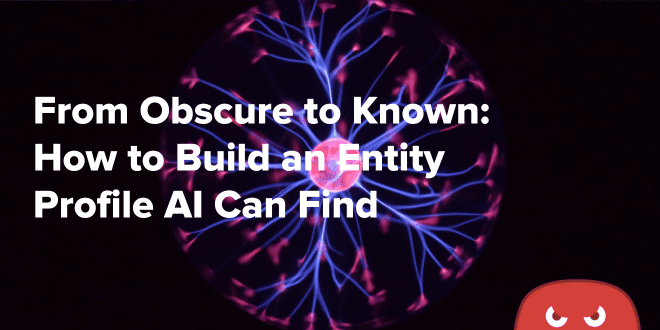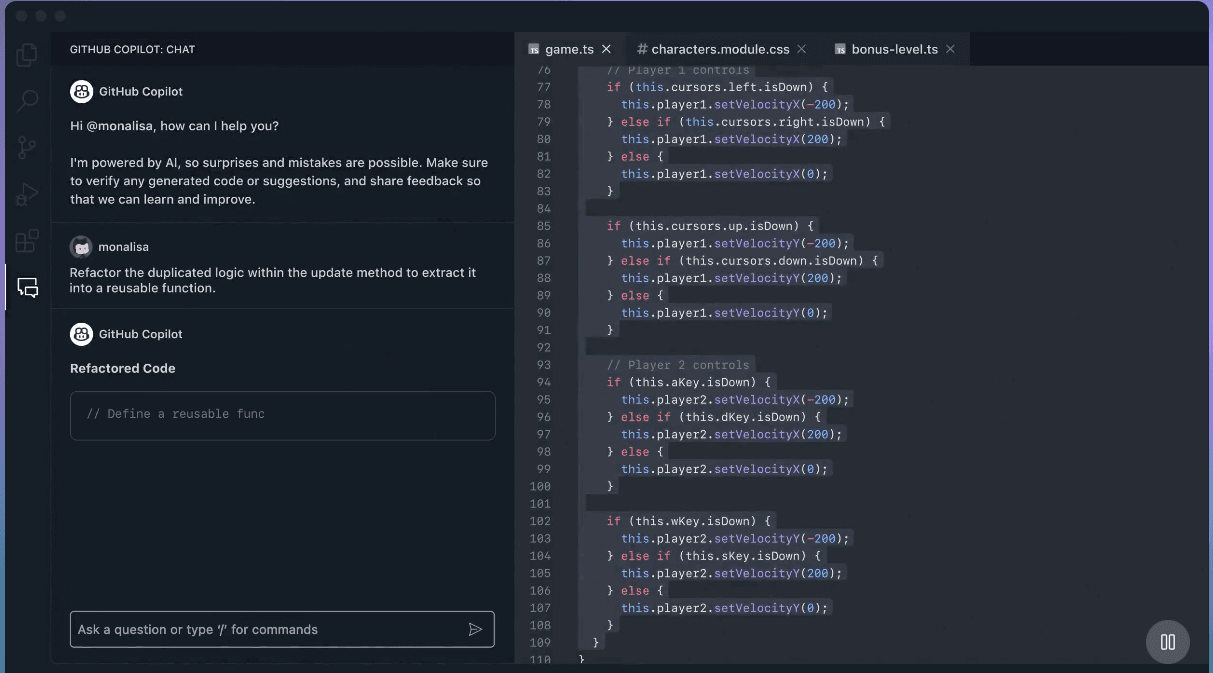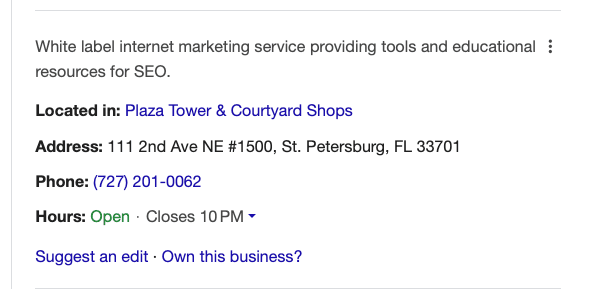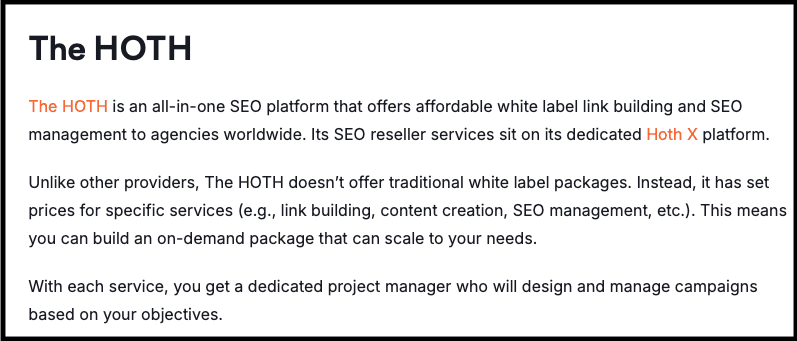
SEO
From Obscure to Known: How to Build an Entity Profile AI Can Find
Rachel HernandezAugust 12th, 2025
If you want to improve your visibility on AI search tools, you have to ‘stick’ in their memory, like a hook in a hit song or a catch phrase from a TV show.
But how do you get an AI search tool to ‘remember’ you?
By engaging in entity SEO for AI, which is what we’re going to unpack in this article.
First, you should know that AI tools don’t remember things the same way we do.
Instead, AIs identify and recall entities (people, places, things, brands, products, etc.) through a combination of:
 Here’s something nobody will dispute: human language is hard to understand.
Words can have multiple meanings, context always matters, and don’t get us started on metaphors.
In other words, interpreting language properly is a tall task, especially for machines.
That’s why AIs use things like LLMs (large language models), natural language processing (NLP), training data, and NER to understand language.
These features grant AIs a level of semantic understanding and ‘memory,’ so to speak.
Whenever we refer to a brand’s entity layer, we’re referring to all the ways AIs can connect your content to your brand. You can think of it as all the information related to your brand in an AI search tool’s ‘memory banks.’
Therefore, your brand’s entity layer includes:
Here’s something nobody will dispute: human language is hard to understand.
Words can have multiple meanings, context always matters, and don’t get us started on metaphors.
In other words, interpreting language properly is a tall task, especially for machines.
That’s why AIs use things like LLMs (large language models), natural language processing (NLP), training data, and NER to understand language.
These features grant AIs a level of semantic understanding and ‘memory,’ so to speak.
Whenever we refer to a brand’s entity layer, we’re referring to all the ways AIs can connect your content to your brand. You can think of it as all the information related to your brand in an AI search tool’s ‘memory banks.’
Therefore, your brand’s entity layer includes:
 AI search assistants and chatbots are trained on massive amounts of structured data, and repositories like GitHub are a goldmine for it.
As a quick refresher, repositories are platforms that store source code, documentation like README files, and version history changes – just to name a few uses.
Major repositories are highly trusted and frequently used by LLMs and search engines. Many LLMs use repositories like GitHub during pretraining, fine-tuning, and for entity recognition.
So, if you’re able to make entries into trusted repositories, you’ll start to build an entity layer for your brand.
The top repositories you should add entries to are:
AI search assistants and chatbots are trained on massive amounts of structured data, and repositories like GitHub are a goldmine for it.
As a quick refresher, repositories are platforms that store source code, documentation like README files, and version history changes – just to name a few uses.
Major repositories are highly trusted and frequently used by LLMs and search engines. Many LLMs use repositories like GitHub during pretraining, fine-tuning, and for entity recognition.
So, if you’re able to make entries into trusted repositories, you’ll start to build an entity layer for your brand.
The top repositories you should add entries to are:
 Next, you need to ensure all your branded information online is as consistent as possible.
That means listing your business’s NAP (name, address, and phone number) the same way every time.
Why does this matter?
Let’s say that on your official website, your address is listed as ‘Suite 235’ but on Yelp, it’s ‘Ste 235.’ Sure, your audience members will know both addresses are the same, but we’re talking about machines here, and semantics are a huge deal.
This tiny inaccuracy could cause LLMs and search crawlers to:
Next, you need to ensure all your branded information online is as consistent as possible.
That means listing your business’s NAP (name, address, and phone number) the same way every time.
Why does this matter?
Let’s say that on your official website, your address is listed as ‘Suite 235’ but on Yelp, it’s ‘Ste 235.’ Sure, your audience members will know both addresses are the same, but we’re talking about machines here, and semantics are a huge deal.
This tiny inaccuracy could cause LLMs and search crawlers to:
Then, there’s the matter of using schema markup to enhance your NAP listings.
Schema markup is an agreed-upon format for structured data that’s used by most major websites. Schemas are special labels for things like products, reviews, and brands.
You can find the full list of schemas at Schema.org.
In terms of NAP accuracy, the most important schemas are:
 Are trusted websites in your niche regularly discussing your brand?
If not, you need to work on your digital PR, because brand mentions are extremely important for entity SEO and overall AI visibility.
According to research by Ahrefs, brand mentions, branded anchors, and brand search volume were the 3 most important visibility factors for LLMs and AI search tools.
So, if you want to appear in more AI-generated summaries (and get LLMs to recommend your products and services), you need to get the internet buzzing about your brand.
The best way to do that is through digital PR tactics like:
Are trusted websites in your niche regularly discussing your brand?
If not, you need to work on your digital PR, because brand mentions are extremely important for entity SEO and overall AI visibility.
According to research by Ahrefs, brand mentions, branded anchors, and brand search volume were the 3 most important visibility factors for LLMs and AI search tools.
So, if you want to appear in more AI-generated summaries (and get LLMs to recommend your products and services), you need to get the internet buzzing about your brand.
The best way to do that is through digital PR tactics like:
- Training data
- NER (named entity recognition)
- Entity linking
- Prominence and search volume
What is the ‘Entity Layer’ for Brands?
 Here’s something nobody will dispute: human language is hard to understand.
Words can have multiple meanings, context always matters, and don’t get us started on metaphors.
In other words, interpreting language properly is a tall task, especially for machines.
That’s why AIs use things like LLMs (large language models), natural language processing (NLP), training data, and NER to understand language.
These features grant AIs a level of semantic understanding and ‘memory,’ so to speak.
Whenever we refer to a brand’s entity layer, we’re referring to all the ways AIs can connect your content to your brand. You can think of it as all the information related to your brand in an AI search tool’s ‘memory banks.’
Therefore, your brand’s entity layer includes:
Here’s something nobody will dispute: human language is hard to understand.
Words can have multiple meanings, context always matters, and don’t get us started on metaphors.
In other words, interpreting language properly is a tall task, especially for machines.
That’s why AIs use things like LLMs (large language models), natural language processing (NLP), training data, and NER to understand language.
These features grant AIs a level of semantic understanding and ‘memory,’ so to speak.
Whenever we refer to a brand’s entity layer, we’re referring to all the ways AIs can connect your content to your brand. You can think of it as all the information related to your brand in an AI search tool’s ‘memory banks.’
Therefore, your brand’s entity layer includes:
- Your brand name
- Logo
- Key personnel
- Products and services
- Brand mentions on trusted websites
- Media coverage, reputations, and reviews
- Website
- Schema markup
- Your brand’s listing in repositories like GitHub and Wikidata
- Social media profiles
- Internal links
Tips for Improving Your Brand’s Entity Layer
Now that you know why having a structured entity layer is essential for AI visibility, let’s learn how to build one. At its core, your entity layer has to deal with:- Your brand identity
- Who you’re connected to (key personnel, authors, etc.)
- Which types of websites mention you
- How authoritative and reliable you are as a source
- How easy it is for LLMs to parse your content
#1: Create entries in trusted repositories
 AI search assistants and chatbots are trained on massive amounts of structured data, and repositories like GitHub are a goldmine for it.
As a quick refresher, repositories are platforms that store source code, documentation like README files, and version history changes – just to name a few uses.
Major repositories are highly trusted and frequently used by LLMs and search engines. Many LLMs use repositories like GitHub during pretraining, fine-tuning, and for entity recognition.
So, if you’re able to make entries into trusted repositories, you’ll start to build an entity layer for your brand.
The top repositories you should add entries to are:
AI search assistants and chatbots are trained on massive amounts of structured data, and repositories like GitHub are a goldmine for it.
As a quick refresher, repositories are platforms that store source code, documentation like README files, and version history changes – just to name a few uses.
Major repositories are highly trusted and frequently used by LLMs and search engines. Many LLMs use repositories like GitHub during pretraining, fine-tuning, and for entity recognition.
So, if you’re able to make entries into trusted repositories, you’ll start to build an entity layer for your brand.
The top repositories you should add entries to are:
- Hosting structured data and public data sets (like industry research or campaign results). Use README files to explain the data. Make sure your descriptions contain relevant keywords and follow a logical semantic structure (i.e., label and describe everything with semantic HTML and schema).
- Creating custom repositories with high-quality, niche-relevant content. For instance, if your niche is marketing, you could create a marketing repository with campaign templates, case studies, and expert interviews.
- Link to your main website in your brand organization’s README file.
- Cross-link to Wikipedia and other repositories (like Wikidata and Crunchbase).
#2: Publish authoritative, consistent profiles
 Next, you need to ensure all your branded information online is as consistent as possible.
That means listing your business’s NAP (name, address, and phone number) the same way every time.
Why does this matter?
Let’s say that on your official website, your address is listed as ‘Suite 235’ but on Yelp, it’s ‘Ste 235.’ Sure, your audience members will know both addresses are the same, but we’re talking about machines here, and semantics are a huge deal.
This tiny inaccuracy could cause LLMs and search crawlers to:
Next, you need to ensure all your branded information online is as consistent as possible.
That means listing your business’s NAP (name, address, and phone number) the same way every time.
Why does this matter?
Let’s say that on your official website, your address is listed as ‘Suite 235’ but on Yelp, it’s ‘Ste 235.’ Sure, your audience members will know both addresses are the same, but we’re talking about machines here, and semantics are a huge deal.
This tiny inaccuracy could cause LLMs and search crawlers to:
- Misidentify the Yelp address as a second branch
- Fail to associate reviews and mentions with your brand
- Not consolidate all your mentions into a single brand entity
| Is your NAP consistency a mess? We’re well aware that updating your business’s NAP across the entire internet is a huge pain in the neck, which is why we offer our Local Citation Cleanup Service! |
- Organization (helps LLMs associate your brand name with an actual business)
- LocalBusiness (for businesses with physical locations)
#3: Earn brand mentions on trusted websites
 Are trusted websites in your niche regularly discussing your brand?
If not, you need to work on your digital PR, because brand mentions are extremely important for entity SEO and overall AI visibility.
According to research by Ahrefs, brand mentions, branded anchors, and brand search volume were the 3 most important visibility factors for LLMs and AI search tools.
So, if you want to appear in more AI-generated summaries (and get LLMs to recommend your products and services), you need to get the internet buzzing about your brand.
The best way to do that is through digital PR tactics like:
Are trusted websites in your niche regularly discussing your brand?
If not, you need to work on your digital PR, because brand mentions are extremely important for entity SEO and overall AI visibility.
According to research by Ahrefs, brand mentions, branded anchors, and brand search volume were the 3 most important visibility factors for LLMs and AI search tools.
So, if you want to appear in more AI-generated summaries (and get LLMs to recommend your products and services), you need to get the internet buzzing about your brand.
The best way to do that is through digital PR tactics like:
- Newsjacking (placing your brand at the forefront of trending news stories)
- Journalist outreach through HARO
- Networking with online journalists and bloggers
- Creating thought leader content and original research
| Want more brand mentions and premium backlinks? Don’t wait to check out our expert Digital PR services! |
#4: Use structured data to reinforce brand identity
Lastly, you should lean heavily into schema markup to fortify your entity layer and improve AI visibility. As previously mentioned, schemas add context to your content by adding clear labels to things like products and reviews. In terms of your brand’s identity, you’ll want to use the schema sameAs. This schema lets machines know that your organization is ‘the same as’ the one that appears on various other websites. You can use it to link to your Wikipedia entry, your official website, and anywhere else that you appear online. That will allow LLMs to connect your brand to your online presence without any guesswork involved.Final Takeaways: Entity SEO for AI
LLMs can’t recommend your brand if they don’t know you exist, which is why entity layers are so important. With a strong entity layer, LLMs will understand your brand, your expertise, and your authority, drastically improving your chances of appearing in more AI-generated summaries and citations. Do you need help navigating the new AI-dominated search landscape? Schedule a free strategy call with our team to discover the best path forward!The author
Rachel Hernandez
description
Previous
The New SEO Funnel: From Indexing to AI Inclusion
Next
Prompt-Aligned SEO: Writing Content That AI Wants to Summarize
Discussion
Comments
Anju
October 7th, 2025
Great article.
